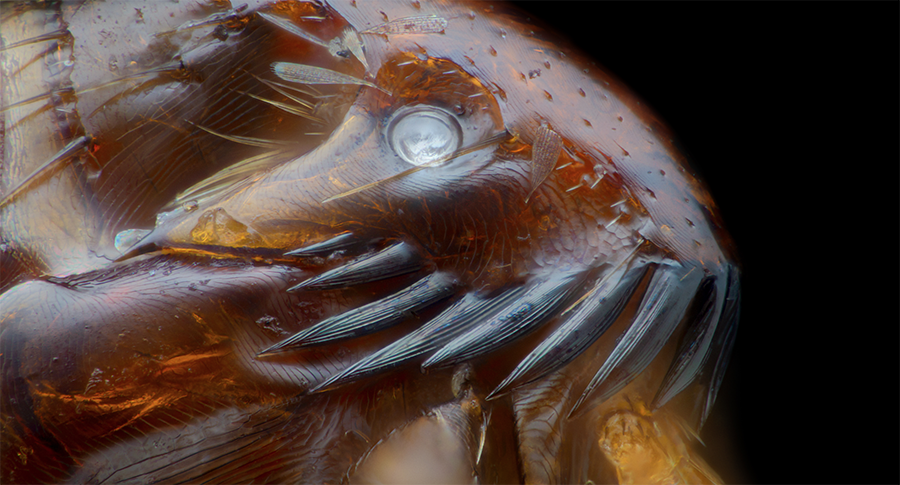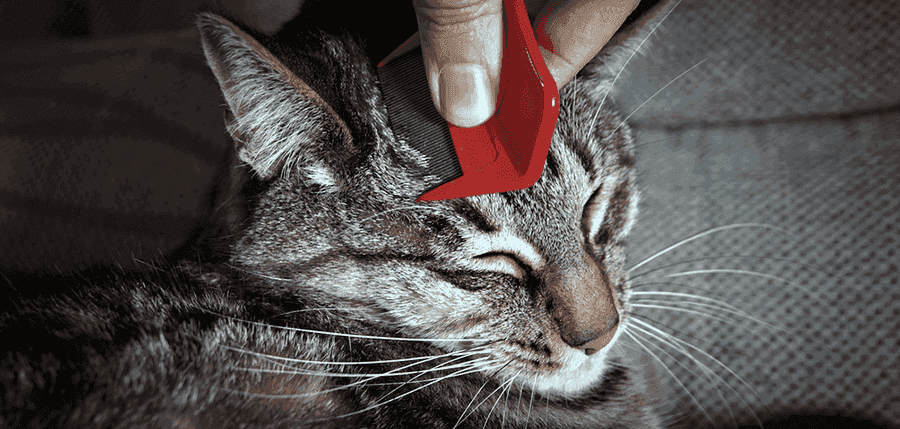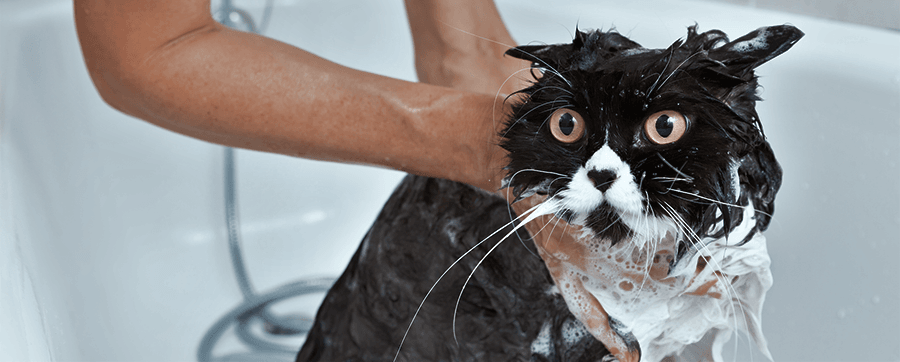
According to research,(1) the cat flea can carry several diseases transferable to humans, such as plague, murine typhus, cat scratch fever, bacterial infections, and tapeworm infestations. Ticks are equally dangerous in spreading Lyme disease, spotted fever, and other diseases.
Also, many pets have flea allergy dermatitis (FAD). In these cases, the pet with this affliction could be bitten just once by a flea and suffer an immediate reaction involving severe itching, hair loss, and skin infection(s).
But fear not! You can easily and safely prevent fleas and ticks. And, If you experience an infestation, you can treat it and return to everyday life.
Fleas & Cats: Fact? Or Myth?
|
Facts |
Myths |
| Your cat can contract fleas even if it never goes outside.
Fleas jump up to 6 inches and attach themselves to shoes, clothes, and pets. Those shoes, clothes, and pets then come into your home. The fleas’ priority is to find a host, and that is your cat. |
I never see fleas on my cat, so my cat can’t possibly have fleas.
You may never actually see a flea on your cat. Cats suffering from lethargy, itching, missing fur, and “hot spots” often receive a flea infestation diagnosis. During exams, veterinary technicians using flea combs often find fleas and or flea “dirt.” |
| Female fleas lay approximately 40 eggs per day or up to 1200 per month!
After just one blood meal from you or your pets, the female flea is very fertile and prolific. |
Kittens and cats don’t die from flea bites.
Fleas can consume 15 times their body weight in blood per day. Young kittens and cats with compromised health may perish from anemia if not treated for fleas. |
| Flea infestations take time to resolve. Consistency, correct use of effective products and patience are key to winning the battle.
In a best-case scenario, it takes three months to rid a home of a flea infestation. In some cases, it can take up to one year. The life cycle of egg, to larvae, to pupae, to adult fleas can take as little as two weeks. However, pupae bury themselves deep within carpets and can lay dormant for or up to one year. |
My cats are outside cats, so I don’t have to worry about cat-to-human transmission of flea-related diseases.
The illnesses we mentioned above are zoonotic, meaning they are transferable to humans directly through fleas or contact with your pet. |
| Fleas are a problem year-round.
In many areas and many climates, fleas are present year-round. Even in the coldest regions of the U.S., flea pupae could be present in your home and emerge when you turn on your furnace. |
Applying flea treatment to my cat should immediately result in fewer fleas, not more.
Fleas rise to the surface, so they become more visible. It may seem like your cat has more fleas when in actuality, the fleas are dying. |
| Flea drops for dogs are NOT safe for cats.
Flea drops for dogs often contain pyrethrins, which are incredibly toxic to cats. |
Natural products with essential oils kill fleas and are healthier for my cat.
Essential-oil based products do not kill fleas and are toxic to cats(2). |

Flea under microscope at 50x magnification
How to Determine if Your Cat Has Fleas: Step By Step
- Wet a white paper towel or white piece of paper and set it aside.
- Using a flea comb, comb your cat’s fur from near the nape of its neck to its tail, ensuring to reach the skin. Do this a few times.
- Look closely at the flea comb, which traps live fleas. If you find just one flea, you have a flea problem.
- If you do not see any live fleas, tap the flea comb contents onto the piece of paper or paper towel.
- If any of the brownish or blackish specks turn red, your cat has fleas. Those specks are flea feces. When the feces turn red, they reveal the blood fleas have consumed and processed.

Checking a kitty with a flea comb
How to Prevent Flea Infestations:
Much like vaccinating your dog for Parvo, flea prevention is much less expensive, safer, and far less stressful than treating for a flea infestation.
| Cost of Flea Prevention | Cost of Treating Flea Infestation |
| $46.00 for three months of topical or oral treatment | $119.00 for three months of spray, powder, shampoo, and immediate relief for cat |
Preventative flea treatment is your first and most effective line of defense unless you’ve just moved into a home previously inhabited by pets not treated with preventatives. In that case, flea pupae may be living in carpets and crevices, waiting for the right opportunity to emerge. According to Mississippi State University, “Newly developed adult fleas that are still inside their cocoons can sense whether or not host animals are present in the area, based on vibrations and carbon dioxide concentrations. When no hosts are present, they will delay emergence from the cocoon for up to several months. This is why heavy flea infestations can emerge suddenly in homes that have been vacant for weeks or months. A new homeowner might exclaim, “We just moved in and the house is full of fleas! No one has lived here for over 3 months and we don’t even have a pet!”
What has usually happened in such situations is that the previous occupants did have indoor pets. After they moved, the flea eggs and larvae that were left behind developed to the pre-adult stage and waited for a new host to arrive. They emerged as soon as they sensed renewed activity, and, in the absence of a dog or cat, began biting people.”
The best way to prevent a flea infestation is to be diligent about administering flea prevention as prescribed. The most common and effective ways to prevent flea infestations are flea drops and oral medication. We strongly recommend a consultation with your veterinarian before choosing a flea preventative for your cat as your vet has insight into your cat’s health. Flea drops provide the broadest spectrum of control, killing fleas, ticks, and even preventing mosquito bites in some cases.
However, the best flea treatment is the one that is best for your cat based on a conversation with your veterinarian.
Flea Drops
If you choose to apply flea drops, it is necessary to use the drops every month for most flea drops. Flea drop chemicals are absorbed into your cat’s sebaceous (skin) glands and then released as part of the natural process of your cat’s body, releasing oils to coat its skin.
- Some drops, such as Bravecto for Cats or Bravecto Plus for Cats last up to 90 days.
- Our recommended flea drop is Frontline Gold Flea & Tick Treatment for Cats. This product not only kills existing fleas and ticks immediately on contact but also contains an Insect Growth Regulator (IGR), which continues to kill flea eggs and larvae on your cat. This product is available over the counter and lasts for 30 days.
- Alternatively, our top pick for prescription flea drops is Revolution for Cats. This product kills fleas, flea eggs, ear mites, roundworms, and hookworms and repels mosquitoes, leading to heartworm disease. Roundworms are the most common intestinal parasite of cats, affecting 25% to 75% of cats, with higher rates in kittens. (3)
| Tip: Cats are incredibly flexible and can reach unimaginable areas on their back. To protect your cat from licking the skin and fur containing the flea drops, apply the drops to the nape of the neck, reasonably close to the top of the head. |
Oral Flea Medication:
Alternatively, you may choose to use an oral flea medication, in which case we recommend Comfortis.
- This product is available by veterinary prescription and does not kill ticks.
- If you live in an area where ticks are prevalent, we recommend a flea and tick preventative.
- We do not recommend flea collars due to their toxicity and safety issues related to most of these products. Many of them are essentially the equivalent of a large zip-tie that goes around your cat’s neck with little option to adjust and no breakaway safety feature.
Flea Prevention Is a Team Sport:
In preventing fleas, it’s critical to treat every pet member of your household (dogs, cats, pocket pets, exotics) with flea preventative products. When applying flea drops to multiple pets, it is vital to separate the pets until the flea drops have dried. Separation is especially crucial in the case of treating dogs where cats are present. Flea drops for dogs often contain pyrethrins, which are incredibly toxic to cats. Remember, NEVER use flea products for dogs on cats. And, don’t assume that flea products designed for cats are safe for other pets. Please consult a veterinarian before embarking on a flea prevention program.
If you have pets that regularly go between indoor and outdoor areas, it’s helpful to maintain a weekly schedule of vacuuming carpets and upholstery and washing your pet’s bedding. Another prevention measure is to ensure that all pets entering your home or coming in contact with your pets are flea free. With family and friends, this can be a difficult topic to broach. If appropriate, please share this article and our flea product review articles with your family and friends so they, too, can feel confident in their decisions about flea control.

How to Treat a Flea Infestation:
If you and your pets are experiencing flea bites, if you see fleas or take a pet to the vet and discover it has a flea problem, assume you have a flea infestation. The lifecycle of a flea is such:
- Fleas lay eggs within two days, and those eggs roll off your pet and into the carpet, crevices, and corners.
- Two days to two weeks later, the eggs mature into larvae.
- One to two weeks later, the larvae develop into pupae. Pupae love dark places and will embed themselves deep into your carpeting, crevices in wood flooring, corners, and spaces between your baseboards and flooring.
Unfortunately, once you have an infestation, treating your pets will not rid you of the issue. You must also treat other pets and your entire home.
Step 1: Provide your feline friend with immediate relief from fleas and ticks.
Shampooing your cat is an excellent, chemical-free way to rid your cat of fleas if your cat will cooperate. Depending on your cat’s age, we recommend either Earthbath Hypo-Allergenic Dog and Cat Shampoo for cats and kittens over six weeks of age or Espree Tear-Free Aloe Vera Puppy & Kitten Shampoo for very young kittens. Not only is shampooing a fantastic way to rid your cat of fleas quickly, but these particular shampoos also provide relief to itchy and irritated skin.

Alternatively, or in addition to shampooing, consider an oral flea medication. called Capstar will immediately rid your cat of fleas within 30 minutes and kill 90% of fleas within 6 hours. Please also use a flea comb to find fleas that these products may not have uncovered and killed immediately.
Neither shampooing nor Capstar will dispatch ticks on your cat. Suppose your cat only has a few ticks. In that case, we recommend manually removing the ticks with a tick removal tool such as the TickEase Tick Removal Tweezer Tool, the TickCheck Premium Tick Remover Kit, or The Original Tick Key. Once removed, kill the ticks by flushing them in the toilet or drowning them in rubbing alcohol. Do not try to remove ticks with your fingers, which may cause tick-borne infections for your cat.
Step 2: Treat your kitten or cat with a longer-lasting preventative flea product.
- Capstar is only effective for up to 24 hours, and shampooing provides only immediate relief. Therefore, it is essential to start treating your cat with flea drops (otherwise known as spot-on treatment) or oral flea medication, depending on your veterinarian’s advice.
- Remember, to eliminate a flea problem, you must treat all other pets in your home.
- Flea drops generally last for 30 days. Some flea drops last up to 90 days.
Step 3: Make a plan, and treat your home for fleas.
- First, vacuum all rugs, carpets, and upholstery (getting down into all furniture crevices) immediately. It’s essential to vacuum areas under and behind furnishings. Pupae prefer dark places, so under furnishings, dark corner crevices, and between and under furniture cushions are especially appealing.
- After vacuuming, do NOT empty the contents of your canister into an indoor garbage receptacle.
- Step outside, and empty the contents of your canister into a bag. For good measure, you can spray a few squirts of disinfectant to wet the contents of the canister. Close the bag and place it in an outdoor garbage bin. If you have a vacuum with a bag, remove the bag outdoors and immediately dispose of it in an outdoor garbage bin.
- Remove all pets and children from your premises. Cover aquarium tanks. Cover, remove, or plan to clean food preparation and serving areas and equipment—plan to launder all bedding and washable textiles in your home.
Step 4: Treat your home using powder or spray.
We recommend using a powder or spray. Understand that in either case, the process is time-consuming and messy, but necessary.
We do not recommend using any of the powders applied directly to your cats. We do, however, suggest a powder called Fleabusters RX for Fleas Plus Powder for your home. This product is made of boric acid (do not use Borax) and binds itself to carpet and textiles, and essentially drains fleas, eggs, and larvae of fluid, killing them. Powder, however, does not kill pupae that remain buried deep in your carpeting and crevices.
- To kill flea pupae, you will, instead, want to choose to use a flea spray in your home. Spraying your home for fleas is an arduous task requiring one to two days and perhaps a night spent away from home for you and your pets.
- After thorough preparation of your home and donning protective gear, begin to spray. Spray carpets, crevices, corners, furniture, and upholstery according to the manufacturer’s directions.
- Let the spray sit for the directed time.
- Then, thoroughly clean all surfaces to ensure flea spray does not come in contact with your pets, you, and your family.
- Launder your bedding and washable textiles. Launder or replace your pets’ bedding.
- And vacuum again, following the same instructions as above. Virbac Knockout E.S. Spray is a spray we recommend as it is odorless, non-staining, non-sticking, and contains an Insect Growth Regulator (IGR), which helps prevent flea re-infestation for up to 7 months.
- Use extreme caution with sprays as they contain toxins dangerous to both humans and pets. Please read and follow the instructions carefully.
- An alternative to using a spray purchased over the counter is to contact a pest control service, but be sure the service uses an IGR.
- Once you have applied in-home treatment, do not steam clean or shampoo your carpets for 4-7 months. If you must steam clean or shampoo your carpets before that time, you will need to reapply a flea spray.
Quick Fact: Premise flea sprays are better than flea bombs. Flea bombs cover only the exposed surfaces, whereas it is more effective to direct flea sprays to the crevices and hidden areas where flea pupae like to reside.
How long does it take to remedy a flea infestation?
Depending on the severity, it can take between three months and one year to completely eradicate a flea infestation.
- For heavy flea infestations, the pupae, hiding in hard-to-reach areas, may continue to emerge, requiring repeat treatments with a household flea spray. Please consult the product label for instructions as to how frequently you can reapply the spray.
- It’s also helpful to regularly comb and test for fleas. Vacuum your home and change the vacuum canister or bag regularly. And make sure any other pets belonging to family, friends, or boarding facilities with which your cat may interact flea free.
In the case of fleas, an ounce of prevention is worth a pound of cure.
The Spots Guide to Flea Products for Cats:
Below is a list of flea products grouped by the manufacturer when the manufacturer offers more than one flea control method. Not all flea products are listed, nor have we listed all the products we’ve reviewed. For example, the flea drop, Revolution for Cats, is not listed below, but its review is in our Best Flea Drops for Cats article.
- Best Flea Collars for Cats
| Product Line: | Family of Products: (*indicates a review) |
| Adams |
|
| Advantage |
|
| Dr. Mercola |
|
| Frontline |
|
| Hartz |
|
| Only Natural |
|
| PetArmor |
|
| Sentry |
|
| Veterinary Formula |
|
| Vet’s Best |
|
| Wondercide |
|
| Zodiac |
|
| Zoecon |
|
Sources:
(1) The Biology and Ecology of Cat Fleas and Advancements in Their Pest Management: A Review, US National Library of Medicine National Institutes of Health, December 8, 2017.
(2) Pet Poison Hotline, ASPCA, Texas A&M University’s Veterinary Medicine and Biomedical Sciences.
(3) Cornell University College of Veterinary Medicine study, Gastrointestinal Parasites of Cats. Accessed July 9, 2019.
